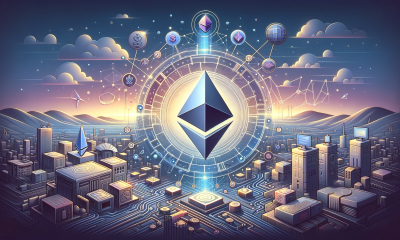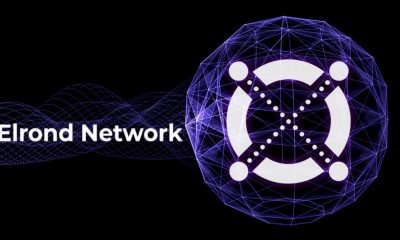Elrond Investor
Investing in Elrond (EGLD) – Everything you Need to Know
By
Gaurav RoySecurities.io is committed to rigorous editorial standards. We may receive compensation when you click on links to products we review. Please view our affiliate disclosure. Trading involves risk which may result in the loss of capital.
Table Of Contents
What is Elrond?
Elrond perfectly sums up what it stands for, “A highly scalable, fast and secure blockchain platform for distributed apps, enterprise use cases, and the new internet economy.” Founded back in 2017, the Elrond network aims to provide faster and cost-effective transactions via smart contracts operated by a distributed network of computers. Brothers Beniamin and Lucian Todea developed Elrond to address the issues related to blockchain scalability. They focused on developing a blockchain platform that is better than any other blockchain platform available back then. They aimed to develop an interoperable and highly-level scalable blockchain platform, and that is how Elrond Network was conceptualized. As for its capabilities, Elrond Network is a truly powerful network. It can process nearly 10,000 to 15,000 transactions per second with an average cost of $0.001.
Elrond Network believes in true decentralization. By using mechanisms, such as sharding and a secure proof-of-stake, the network is designed to compete with the major blockchain platforms like Ethereum, Zilliqa, etc. Moreover, it is the first-ever network where a state, network, and transaction sharding, have all been implemented. Before conducting an IEO, the Malta-based platform went for private funding round and generated around $1.9 million from various angel investors. Later, the network went ahead with an IEO and raised $3.25 million, and exchanged 25% of the total supply of its ELGD tokens.
What Problem Does Elrond Attempt to Solve?
Elrond, which describes itself as a new internet economy for decentralized applications. It mainly aims to provide hassle-free, fast, and cost-effective transactions. Elrond intends to develop its own ecosystem where-in its native token ELGD will be the store-of-value asset. There are three main areas that Elrond attempts to achieve:
Instant and cost-effective transactions
In recent times, increasing transaction fees have become a source of frustration among Ethereum users. Many of them had to shell out hundreds of dollars in transaction fees. At the same time, the congested Bitcoin network has led to users complaining about slower than average transaction speed. Elrond tackles both these problems effectively. It intends to address these issues by providing an efficient and secure platform to carry out transactions.
Minimum energy and computation requirements
As we all know, bitcoin mining requires a huge hardware setup, which, in turn, requires energy in abundance. Bitcoin follows a mechanism known as Proof-of-Work, which is known to be an energy guzzler mechanism globally. In recent times, many leading experts have criticized Bitcoin for its energy consumption. In fact, some sources claim that Bitcoin’s energy consumption is more than what Argentina, a sovereign nation, consumes.
That’s where Proof-of-Stake comes into the picture. It also evens the playing ground as the Proof-of-Stake mechanism does not require equipment worth millions of dollars. Instead, it relies on a process called staking. Proof-of-Stake offers double benefits. The first is minimum energy consumption, and the second is that it removes the high barrier to entry, which benefits many people from the ecosystem instead of a select few. Elrond uses an improvised version of the Proof-of-Stake mechanism, which they call Secure Proof-Of-Stake. It helps Elrond be faster, secure, and fair.
A strong decentralized structure, minimizing a single-point-of-failure
By combining the decentralized structure with cross-chain interoperability, Elrond reduces the possibility of a single point of failure that may impact the whole system in the worst cases. The network runs on 2169 validator nodes, split into four shards, capable of executing 5,400 transactions per second each and a coordination shard.
How Does Elrond's Secure Proof-Of-Stake Work?
When it comes to similarities between the plain old Proof-of-Stake and Elrond’s Secure Proof-Of-Stake, both rely on the number of staked tokens to select validator nodes for consensus. Now, let us see how Secure PoS works.
Elrond’s Secure PoS' consensus mechanism is specifically built to choose the nodes, who, in turn, build blocks. They are responsible for completing the overall consensus process, which takes place in some particular shards. As for the selection of validators, Elrond uses randomness to do so. For validator selection, the Secure Proof-Of-Stake mechanism relies on a randomness formula. The formula is derived from the preceding block. Once the process completes, the block proposer of the current round of consensus signs it.
There is only one block proposer in every consensus group. After every round, the members of the consensus group are changed. In a consensus group, the block proposer is the validator. Their public key and randomization factors' hash is the smallest in the group. It is the duty to produce the block rests on the block proposer, whereas other members in the consensus group validate and sign it. The consensus group uses a modified BLS multi-signature scheme consisting of two rounds of messaging for block signature.
The random selection of consensus groups is quick and gets completed within 100 milliseconds. This randomized process of selecting consensus groups ensures better security in the Elrond network as any bad elements will fail to take any action within 100 milliseconds.
The selection of consensus takes multiple factors into account, including the number of staked tokens and the individual rating score of the validator. So, how is this individual rating score of a validator calculated? Well, the past behavior of the validator plays a crucial role in their individual rating score. It means that a validator having a higher individual rating score has a higher chance of getting selected for the consensus process.
Barring a few specific instances where the ratings are adjusted right away, the recalculation of individual rating scores always happens at the end of each epoch. The Elrond ecosystem benefits from its unique rating mechanism as it gets the validator to do their work honestly, and regardless of what may come, they ensure that the nodes keep on operating at the highest efficiency possible.
The Architecture
Before digging deep into the products of Elrond, let us first take a look at Elrond's architecture. The network structure comprises Shards, Metachains, and Nodes. Shards are the smaller partitions of the Elrond network which are used for scaling. Each shard processes only a fraction of transactions, simultaneously with other shards. The shards are responsible for executing accounts, smart contracts, blockchains, etc, which plays a crucial role in scaling.
The next comes the Meta chain, which is nothing but a blockchain that runs on a special shard. The main aim of this blockchain is not to process the transactions but to authenticate the processed block. Also, it takes care of the communication between the shards, maintains the registry of validators, rewarding and slashing
The last is the Nodes, which are an integral part of the network. In fact, many nodes, which can be a smartphone, a computer, or a server, come together to form a network. Among these nodes, some act as validators while some as observers. Hence providing different levels of support to the network and earn rewards for their work.
Elrond Platform, Infrastructure, and Token
The developers and validators can use Elrond to create decentralized applications and use its native token as a payment method. The Elrond Integrated development environment enables the developers to launch their services on their platform. It also offers a smart contract engine, which makes EVM compliance possible that enables blockchain interoperability. The Elrond platform enables adaptive state sharding to offer higher throughout, rivaling that of the centralized platforms.
The platform also encourages developers to create more innovative and cost-effective applications and earn up to 30% of the smart contract fees as royalties. The network also reserves some ELGD tokens, which are staked on the platform for a minimum period of a year and earn a 36% annual rate.
We can even count ELGD tokens as a product of Elrond Network, after all, the validators need to stake them to secure the ledger. The Elrond infrastructure also offers a wallet to its users and the block explorer.
Elrond eGold or ELGD coin is the native token of Elrond, and it used to interact with applications, carry out transactions and give out rewards or incentives. Initially, the native token was named ERD coin. But after launching the token on the main net, it was renamed as ELGD coin. Later the network also held a swapping program and enabled the users to swap the old tokens to the new ones.
Elrond’s native cryptocurrency plays a vital role in maintaining a network. You can also use it for sending, rewarding the network contributors, and also running smart contracts. The people who own ELGD tokens are eligible to participate in the voting process for any developments on the network. Moreover, they will receive rewards with newly minted tokens that would be proportional to the amount staked.
The transaction fees collected are not utilized completely by the network. Instead, a part of the fees collected, 30% to be specific, is sent to the smart contract developers. It is known as smart contract loyalties. In addition to this, 10% of the fees would be rewarded to the community participants participating in some special events like bounty projects and network development. As for its supply, ELGD has a maximum supply of over 30 million tokens and a total supply of over 20 million.
How to Buy Elrond (EGLD)
Elrond (EGLD) is currently available for purchase on the following exchanges:
Uphold – This is one of the top exchanges for United States & UK residents that offers a wide range of cryptocurrencies. Germany & Netherlands are prohibited.
Kraken – Founded in 2011, Kraken is one of the most trusted names in the industry with over 9,000,000 users, and over $207 billion in quarterly trading volume.
The Kraken exchange offers trading access to over 190 countries including Australia, Canada, Europe, and is a top exchange for USA residents. (Excluding New York & Washington state).
WazirX – This exchange is part of the Binance Group, which ensures a high standard of quality. It is the best exchange for residents of India.
Uphold Disclaimer: Terms Apply. Cryptoassets are highly volatile. Your capital is at risk. Don’t invest unless you’re prepared to lose all the money you invest. This is a high-risk investment, and you should not expect to be protected if something goes wrong..
Elrond Platform – The Sonic Hedgehog of Blockchain Space
Elrond competes against Ethereum, similar to Cardano and Polkadot. Thus, it faces immense competition from some of the leading platforms in the world of blockchain like Ethereum, Cardano, Polkadot. Yet, it has the potential to compete against them, and that, too, strongly. It has multiple features that rival the leading blockchain platforms. Elrond also inked partnerships with some of the top-most names in the crypto industry like Ledger, PolyNetwork, BitGo, Coinbase Custody, and more.
The adaptive stake sharding, secured Proof-of-Stake, Arwen Machine technology enables Elrond to process a high number of transactions, which should put Elrond in a league of its own. With further development, the Elrond platform will see an increase in transactions. Moreover, the biggest plus point with the Elrond platform is its strong support for blockchain interoperability.
Gaurav started trading cryptocurrencies in 2017 and has fallen in love with the crypto space ever since. His interest in everything crypto turned him into a writer specializing in cryptocurrencies and blockchain. Soon he found himself working with crypto companies and media outlets. He is also a big-time Batman fan.
You may like


Investing In Ethereum (ETH) – Everything You Need to Know


Binance Suspends Elrond Withdrawal and Deposit Services After Massive Hack


Next-gen Analytics that will Make Web3 Secure Just Went Live on Elrond


Elrond Introduces a New Price Discovery Mechanism


Elrond (EGLD) Price on the Rise, Recovers by 14% in the Last Week


Top 7 New Cryptocurrencies that will Make Gains